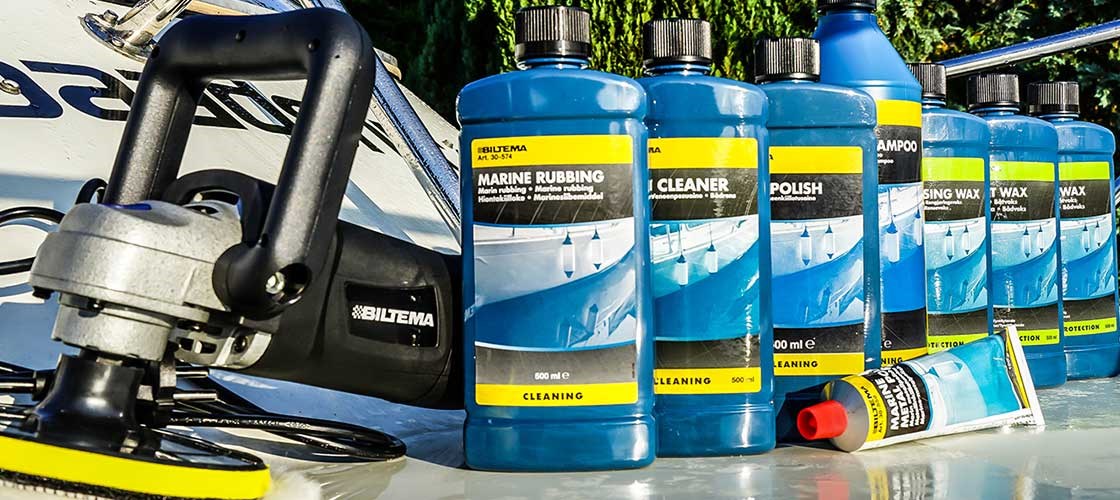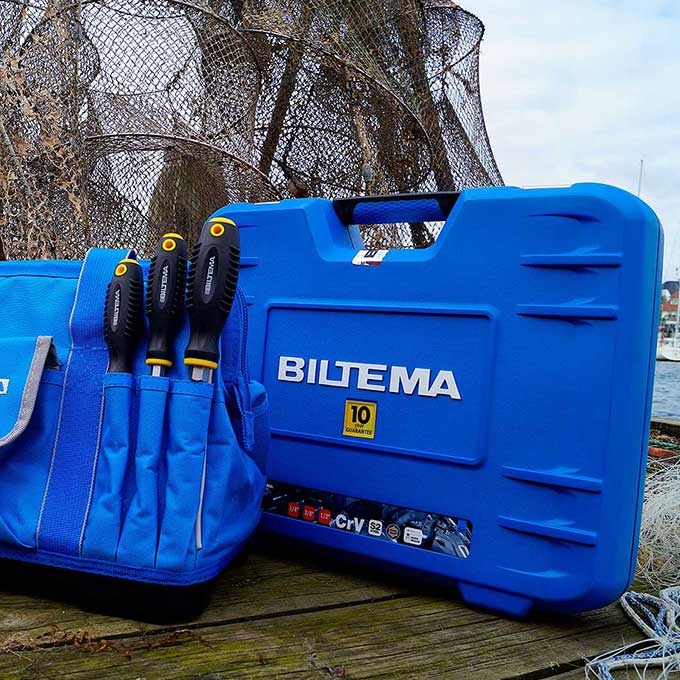Tips for polishing the boat
The polishing provides effective protection against the elements and the sun's UV rays. Based on Biltema's boat care products, here we provide safe tips to make the job easier and with an approved result.

"Cleaning" and "Protection" - In an informative way, the polishing products are divided into "Cleaning" and "Protection", which is indicated with the colour codes yellow and green.
Tip: Remember that the best results when polishing your boat are achieved if the work is not done in direct sunlight.
STEP 1: Make sure you give your boat a good wash. First, rinse the boat thoroughly with clean water and then wash it with a good boat shampoo. We used Biltema's boat shampoo, which we mixed in a 10-litre bucket in a 15:1 ratio, although you can use a stronger solution of 5-10 parts water if your boat is very dirty. Use a soft brush to apply the shampoo, leave it on for a few minutes without letting it dry and agitate the dirty areas with a brush, then rinse with water.
STEP 2: The fibreglass is first cleaned with Boat Cleaner, a silicone-free cleaning polish. It deep cleans without abrasion. Apply with a cloth and allow to dry until the surface appears matt, then wipe off with a cloth again. Work on a small area at a time.
STEP 3: If your gelcoat has turned yellow, it may be a good idea to give it a refresh with Marine Rubbing, a very light abrasive that deep cleans, leaving the fibreglass white and smooth. For this light “rubbing” we use the polisher with a foam pad at approx. 800 rpm. Remember to move the polisher in a criss-cross pattern when polishing to avoid swirl marks. If your boat has a nice finish, this step can be skipped. Rubbing is also excellent if there are places on the boat where rust has run down the white fiberglass or if it has yellowed around the waterline.

Remember the wax - Also remember to give the boat engine a coat of wax to protect it from corrosion.
STEP 4: Once the surface is clean and smooth, protect it with a coat of wax. There are several different options and wax products to choose from here, but what they all have in common is that they close the pores of the fibreglass and keep it protected throughout the season. Work on areas of approximately 1x1 metres and apply the wax with a soft cloth, working it well into the surface. Then allow the wax to dry until a grey film is visible.
STEP 5: Now it is time to polish and this is where good prep work becomes visible - A polishing machine makes the work easier and gives a better result, as the many rotations of the polishing head are difficult to replicate with hand polishing. Go over the area to be polished several times and make sure that the polishing pad is always clean and dry without lumps of wax stuck in it. Be careful not to press too hard against the fibreglass and do not use too high a speed on the polisher - we are using 500-800 rpm here. A good tip is to have an extra polishing pad, as they can also wear out. If you can, give your boat two coats of wax - it will give it a longer lifespan, but as a general rule, a wax treatment lasts about 5-6 months.
Find the right polishing machine>>
STEP 6: Once you have polished the fibreglass, you can move on to other areas of the boat and stainless steel handrails, ladders and fittings are one of them. Although made of stainless steel, the harsh environment can cause surface rust. It can especially occur around joints and welds, it can occur and it is a good idea to get rid of it. Use Marine Metal polish, applied with a cotton cloth, to gently polish away rust and leave the surface shiny and presentable.

A few tips to keep the polishing work looking good:
- Wash and rinse the boat after each use. Preferably with boat shampoo and never with “degreasing” detergents such as washing-up liquid and the like.
- If you use your boat for fishing, it is important to rinse off dirt quickly before it sticks - the same goes for other waste products.
- REMEMBER the inside of the boat when polishing, it is just as exposed to wear and tear.
- Use a toothbrush to get into the corners around guardrails, etc.
- Do not forget about the engine. It is made of aluminium and the paint protects it, so give it a good polish with a polishing cloth as well.




